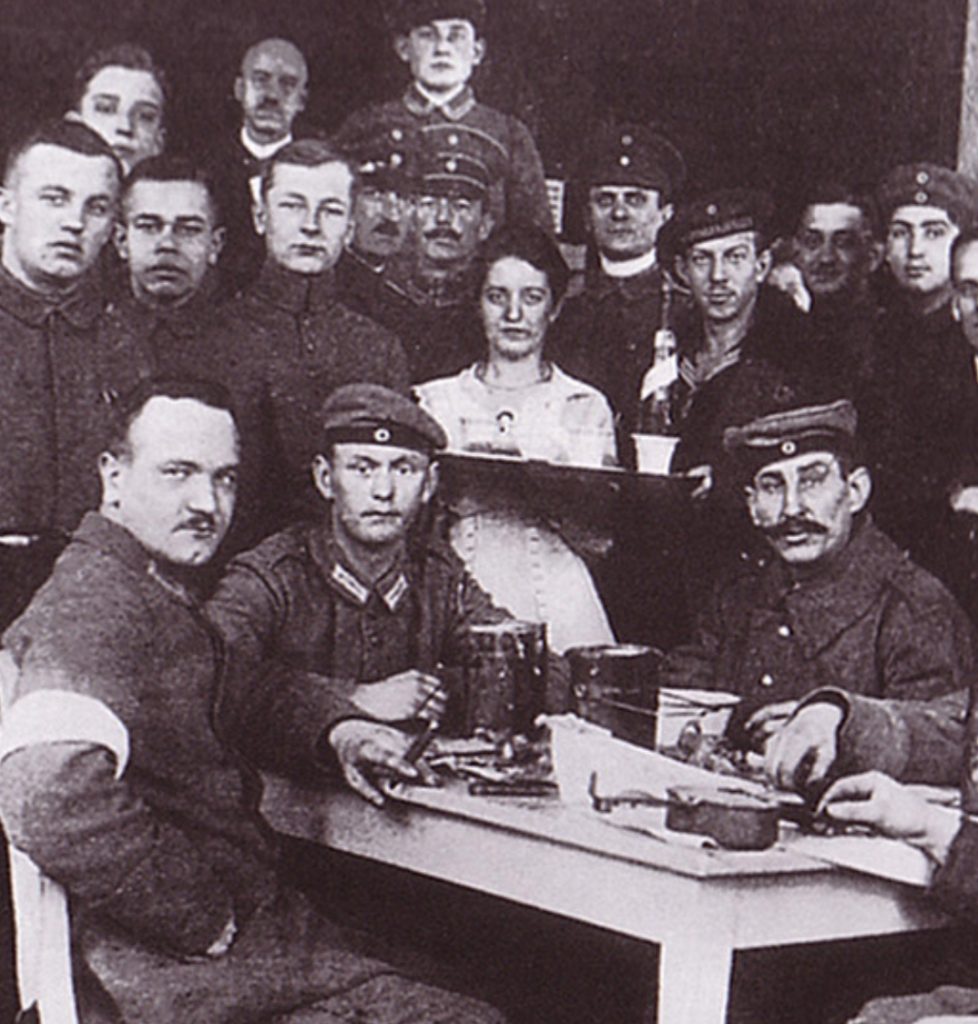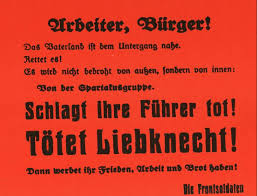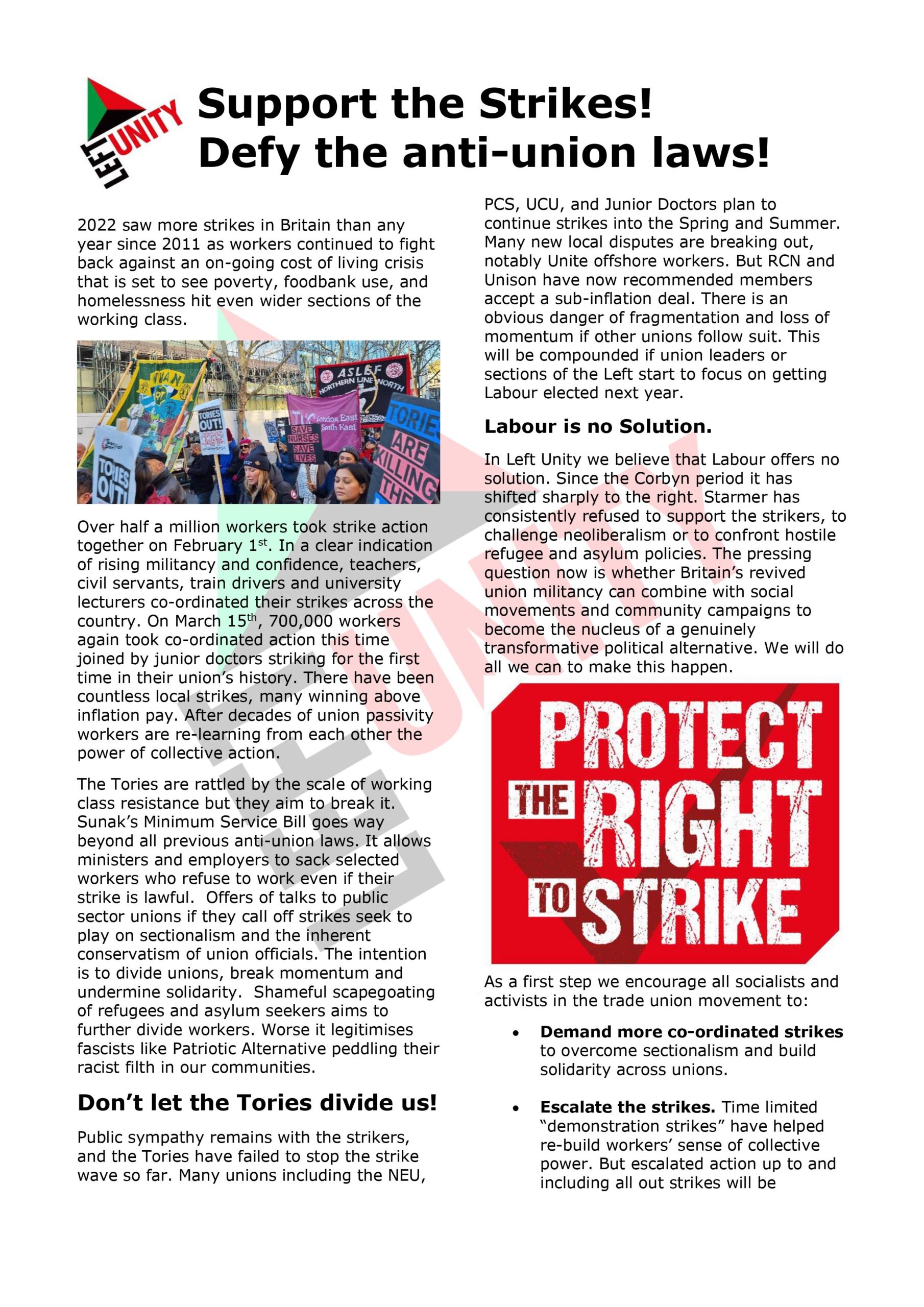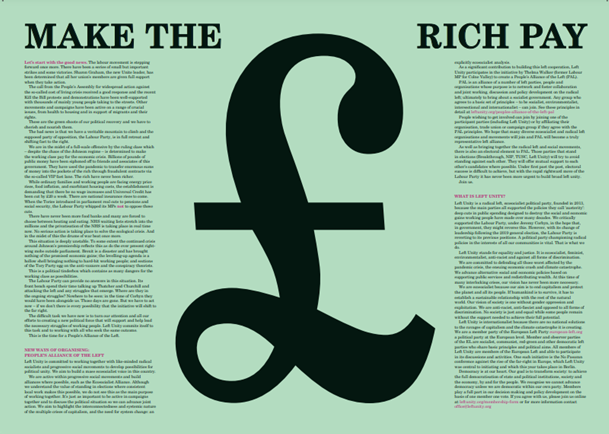Luxemburg, Liebknecht and the German Revolution

Members of the Garde-Kavallerie-Schutz-Division (GKSD)
A month after the double murder of Karl Liebknecht and Rosa Luxemburg a photo appeared in the Communist Rote Fahne (Red Flag) newspaper, writes Nick Jones. The photo was taken 16th January at the Eden Hotel by 24 year old Fritz Eichner.
The man with the moustache in the centre of the photo is Rifleman Otto Wilhelm Runge. A welder by trade, he was found guilty of smashing the skulls of Rosa Luxemburg and Karl Liebknecht with a rifle butt, and was the only one committed to prison for the crime.
The man behind him in a sailor’s uniform was 28 year old Edwin von Rzewuski, engineer fitter, who leapt onto the vehicle to punch Luxemburg and Liebknecht in the car, making him a murder suspect.
The waitress holding the tray is 28 year old Gertrud Zöllner.
The two men seated below the waitress are riflemen Poppe (20) and Weber (26), who carried out officers’ orders to throw Rosa Luxemburg’s corpse into the Landwehr canal.
Businessman and Chair of the Wilmersdorf Council, Fabian, paid the 8 soldiers a massive 13,600 Mark reward.

Karl Liebknecht
The murder of Karl Liebknecht and Rosa Luxemburg was one of the greatest tragedies of the twentieth century.
Rosa Luxemburg had been released from prison on the 9th November 1918. Liebknecht was barely involved in the workers’ revolt. The revolutionary sailors, trade unionists and soldiers took centre stage in numerous strikes, debates and protests.
That said, the names of Liebknecht and Luxemburghad been influential and inspired the anti-war and revolutionary socialist movement of the Spartacist Group. Both suffered imprisonment and persecution for opposing the slaughter of World War One. The clarity of their ideas and unswerving support for workers’ control and the destruction of the old order gave them international acclaim. The fact that Rosa Luxemburg was Jewish and a woman enraged conservatives and German nationalists.
In Germany 1918, the old order was collapsing under the pressure of war. Food shortages and strike action was growing. Attempts to intimidate the revolutionary trade union representatives of the Revolutionäre Gewerkschafts Opposition (Revolutionary Union Opposition) or RGO, had failed. Despite dismissal, imprisonment or sending them to fight at the front, the group reformed and had the support of people in the factories and communities. They had formed a powerful network capable of paralysing industry through strike action creating pressure to end the war on the home front.
…….
The German General Staff and Kaiser knew the war was lost 29th September 1918, but some were still willing to sacrifice thousands more lives.The process to end the First World War was accelerated by revolutionary sailors who refused orders to attack British ships in Kiel. Their revolt spread across Germany. Hundreds of thousands of workers took strike action and the German Social Democratic Party plans for a Constitutional Monarchy and Parliament were left literally blowing along the streets of Berlin – the striking workers threw their leaflets to the ground. The call to support army officers and return to work or barracks was ignored.
As workers and soldiers marched on the German Parliament 9th November 1918, the SPD leader Friedrich Ebert was quietly eating his potato soup with fellow SPD Leader Phillip Scheideman. A crowd of MPs barged into the room demanding action[1]. Workers were heard chanting slogans – “Down with the Kaiser! Down with the war! Long Live the Republic!” There were rumours that revolutionary socialist Karl Liebknecht was going to demand a socialist republic.
Ebert shook his head and continued to eat his soup. Phillip Scheidemann left his soup and walked down the corridor towards the balcony to address the jubilant crowd:
“The people have won! Long live the Republic!”
Then he returned to his table.
Karl Liebknecht declared the Socialist Republic from the Kaiser’s Palace a mile down the road.
Many workers and soldiers were influenced by the ideas of the Socialist Revolution in Russia 1917. The tension between the radical Workers’ and Soldiers’ Council in Berlin, who sought public ownership and nationalisation of banks and companies, conflicted with the conservative trade union labour leaders of the SPD. The newly elected Soldiers’ and Workers’ Councils and leader Richard Müller hoped to organise a new social and economic order from below – run by the people in the interests of the people. Delegates had already been directly elected by ballot on Sunday 10th November, in factories and army barracks.
The resolution passed on 24th November by the German National Workers’ and Soldiers’ Council Berlin[2] placed the control of food, raw materials, money and law and order in the hands of the Committee. They ensured housing for the homeless, widows and children. Empty office space, vacant properties were seized and converted into emergency accommodation. Large canteens opened to feed the poor. Hygiene facilities for washing and bathing installed to help prevent the spread of disease. They ensured the unemployed received money. Soldiers returning from war were guaranteed medical treatment and care, housed and given money.
Müller reports how technicians, engineers, architects, doctors and chemists were keen to help with projects to nationalise industry and the banks at the beginning. This was opposed by conservative union leaders in the SPD and business opposing the workers’ right to control production and distribution of goods.
Stormy exchanges in the Council meetings took place. SPD union Leader Adolf Cohen argued against workers’ control, stating that unions had made progress with collective wage agreements, holiday entitlements and a reduction in working hours to 46 ½ hours a week[3]. SPD representative Kaliski told workers to be reasonable, and accept that they simply did not have the technical skills or knowledge to run a big company.
“Don’t confuse class consciousness with delusions of grandeur!”[4]
The leadership of the SPD with the aid of officers, business leaders, conservatives and nationalists were horrified by the threat of a socialist government under workers’ and soldiers’ control. They argued for an end to such ‘Bolshevik antisocial experiments’ that were divisive and dictatorial; now was the time to come together for the sake of the Nation[5]. Their arguments, leaflets and newspaper articles calling for unity and a national meeting were well received by workers and soldiers.
The National Joint Council of Workers and Soldiers met from 16th-21st December in Berlin. The main debate being: A Workers’ and Soldiers’ Council or a National Parliament?
The calls for unity were won and the SPD alongside more radical left socialists of the USPD took leadership positions. Liebknecht turned down the invitation to join. The Internationale was sung and revolutionary fists were raised.
Richard Muller noted, “Following the elections it was clear the right-wing socialists and independents had the majority…The right would seek to break the Workers and Soldiers Councils …the revolution was lost.”[6]
The Government ordered the counter revolutionary troops into Berlin. The Government forces attacked the revolutionary sailors on the 24th December and the violent counter revolution began. The funeral of the victims took place on Sunday 29th December, the crowds shouting:
“Down with the traitors!” and demanded retaliation, “Violence against Violence!”
Revolutionary socialists and radial trade unionists met and launched the German Communist Party and began to mobilise and fight for a socialist republic on the 1st January 1919 with Liebknecht and Luxemburg in leadership positions.
Street battles took place in early January. The course was set and the Socialist Minister of Defence Gustav Noske was clear about the need to suppress the revolution, remarking “…someone has to be the bloodhound!”.
 Posters went up across Berlin demanding death to Liebknecht and Luxemburg. Antisemitic leaflets poured out and a festival of reaction began.
Posters went up across Berlin demanding death to Liebknecht and Luxemburg. Antisemitic leaflets poured out and a festival of reaction began.
At 9.00pm 15th January Rosa Luxemburg and Karl Liebknecht were arrested and taken to the Eden Hotel, Headquarters of counterrevolutionary soldiers the Garde-Kavallerie-Schutz-Division (GKSD).
At 10.45pm Liebknecht was led out – abused and spat on by hotel guests, led downstairs to a side entrance. Liebknecht was then placed in a car- struck twice on the head with a rifle – then punched in the head by Sailor Rzeweski.
Liebknecht was driven to the lake ‘Am Neuen See’ in Berlin Tiergarten. The car broke down on the way, so his body was dragged through the park. He was then shot and his body dumped in the lake. His corpse was discovered at 11.15pm.
At 11.40pm Rosa Luxemburg was led out through the angry crowd. On the way to the car, Rifleman Runge struck her head with a rifle butt and knocked her unconscious. She stumbled and lost a shoe. She was struck on the head again then thrown in to the car. Her shoe was kept by soldier Kurt Bececker as a trophy, and another soldier, Albrecht Freiherr, stole a letter from Clara Zetkin, from her handbag, which was later sold to historian Herman Weber in 1969[7].
About forty meters from the Hotel Eden a shot rang out. Lietenant Souchcon had placed a Mauserpistole 7,65 to Rosa’s left temple and fired, shattering her skull and dislocating her jaw, killing her instantly at 11.45pm 15th January 1919.
Lieutenant Vogel threw her body into Landwehr canal near the bridge. Her body was not discovered until 31st May 1919 ,by a canal worker Lockman Knepel.
When Richard Müller in the name of the Workers’ and Soldiers’ Council demanded that a special commission be established to investigate the murder, the SPD ignored the request.
On 12th February 1919, Leo Jogiches published evidence in the Rote Fahne linking their murder to the army and SPD. Leo Jogiches was arrested in March 1919, and ‘shot whilst escaping’.
The murder of Rosa Luxemburg and Karl Liebknecht was shrouded in mystery for many years.
Knowing that he could no longer be prosecuted, former Captain Waldemar Pabst, at a trial in Stuttgart in 1969, confessed that he had ordered the murder following a telephone call to SPD Defence Minister Noske.
The forces of the state alongside treacherous SPD leaders had crushed the attempts to build a democratic socialist society, for the many, from below.
The 15th January marks the 100th Anniversary of this tragic event.
[1] Die Deutsche Revolution 1918-1919, Sebastian Haffner, Knaur 1991, p.78
[2]Vollzugsrat des Arbeiter- und Soldatenrates und die Arbeiter- und SoldatenräterDeutschlands , 23. November 1918, p.36-38, Die Rätebewegung Band 1, Rohwolt, März 1971
[3] Der VollzugsratKämpft um die Arbeiter-Kontrolle, R. Müller, pp 30-34, Die Rätebewegung Band 1, Rohwolt, März 1971
[4] ibid
[5] SPD Flugblatt-Eine Riesenlast, pp62-65, Die Rätebewegung Band 1, Rohwolt, März 1971
[6] P98, Die deutsche Revolution 1918-1919, Sebastian Haffner, Knaur 1991
[7] Eine LeicheimLandwehrkanal: Die Ermordung der Rosa Luxemburg, Klaus Gietinger, 1995, Verlag Berlin 1900
Left Unity is active in movements and campaigns across the left, working to create an alternative to the main political parties.
About Left Unity
Read our manifesto
Left Unity is a member of the European Left Party. 
Read the European Left Manifesto
ACTIVIST CALENDAR
Events and protests from around the movement, and local Left Unity meetings.

Saturday 19th July: End the Genocide – national march for Palestine
Join us to tell the government to end the genocide; stop arming Israel; and stop starving Gaza!
Summer University, 11-13 July, in Paris
Peace, planet, people: our common struggle
The EL’s annual summer university is taking place in Paris.
More events »
GET UPDATES
Sign up to the Left Unity email newsletter.
CAMPAIGNING MATERIALS
Get the latest Left Unity resources.


